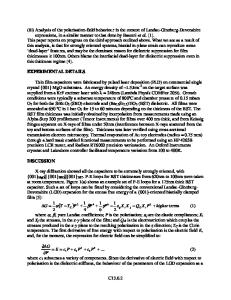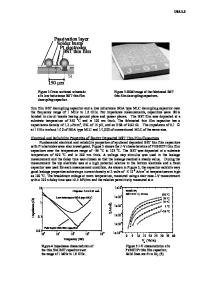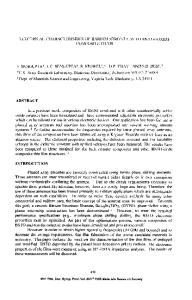Fabrication of on-chip barium strontium titanate capacitors by metallo-organic decomposition
- PDF / 247,416 Bytes
- 5 Pages / 612 x 792 pts (letter) Page_size
- 63 Downloads / 325 Views
MATERIALS RESEARCH
Welcome
Comments
Help
Fabrication of on-chip barium strontium titanate capacitors by metallo-organic decomposition Antonio B. Catalan and Shih-Chia Chang Electrical and Electronics Engineering Department, General Motors Research and Development Laboratories, Warren, Michigan 48090-9055
Roger J. Poisson and William J. Baney Advanced Spec. MOS Department, Delco Electronics Corporation, Kokomo, Indiana 46904-9005
John E. Benci Materials Science Department, Wayne State University, Detroit, Michigan 48202 (Received 26 March 1997; accepted 31 December 1997)
Metallo-organic thin film decomposition (MOD) was used in forming barium strontium titanate (BST) thin film capacitors on phosphorus doped polysilicon films deposited on 4 in. silicon wafers. A single step deposition process yielded highly uniform, crack-free BST films ranging up to 0.25 mm in thickness and having various step heights and dimensional area. Scanning electron microscopy (SEM) showed very good step coverage and planarization of the BST. The capacitors had capacitance densities above 200 nFycm2 , leakage current densities less than 1.55 mAycm2 at a bias voltage of 10 V, and a dielectric breakdown field above 1 MVycm. Small temperature coefficients of capacitance and dissipation (tan d) were also observed. Frequency response measurements were made using the BST capacitors and on-chip resistors in low pass and high pass circuit configurations. A plot of relative gain and phase angle versus frequency showed excellent agreement with predicted results.
I. INTRODUCTION
The increasing trend toward size reduction of IC’s has spurred a considerable amount of effort at decreasing the size of capacitive components. One area of active interest lies in the development of a thin film process that enables one to greatly reduce capacitor area on the chip while maintaining the cell capacitance. Thus, the development of high permittivity low loss thin film materials are of enormous interest.1,2 Many high dielectric ceramic oxide materials have been investigated for their use as high density storage capacitors,3–5 particularly in the fabrication of dynamic random access memory (DRAM) cells. Thin films of lead zirconate titanate,5 barium titanate,3 tantalum oxide,8 and strontium titanate,7,8 have been fabricated using sol-gel, CVD, and sputter deposition techniques. An alternative thin film technique for the deposition of such materials is the metallo-organic decomposition (MOD) process, which is a silicon compatible, potentially low cost, simple deposition process for controlling the composition of multicomponent systems.4,9 The MOD process is a spin-on technique very similar to the deposition of photoresist which may easily be integrated in a IC production facility. However, it has traditionally been necessary to do multiple coatings to obtain a desired film thickness. This can add complexity and inconsistency to the film fabrication process. In a 1548
http://journals.cambridge.org
J. Mater. Res., Vol. 13, No. 6, Jun 1998
Downloaded: 14 Mar 2
Data Loading...











